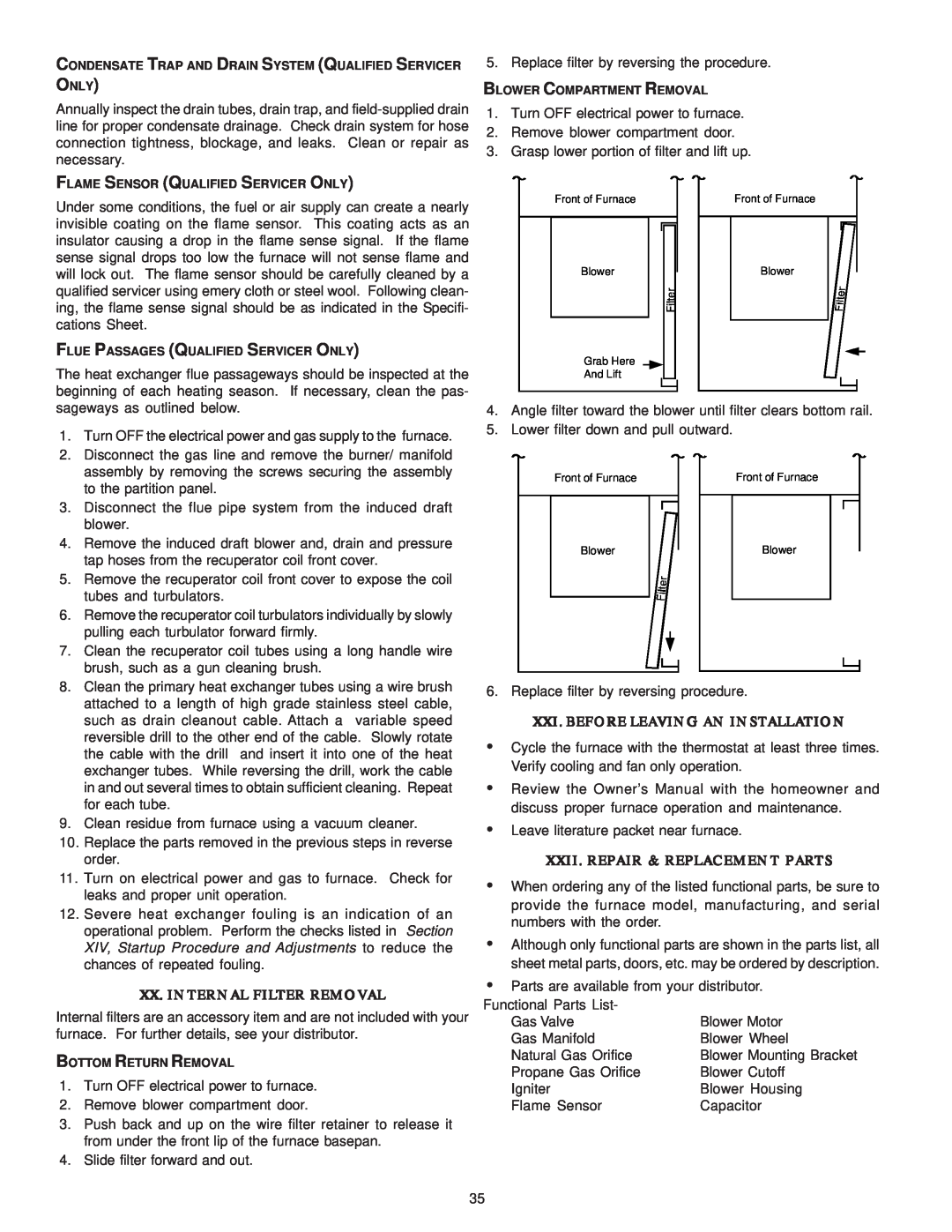
CONDENSATE TRAP AND DRAIN SYSTEM (QUALIFIED SERVICER ONLY)
Annually inspect the drain tubes, drain trap, and
FLAME SENSOR (QUALIFIED SERVICER ONLY)
5. Replace filter by reversing the procedure.
BLOWER COMPARTMENT REMOVAL
1.Turn OFF electrical power to furnace.
2.Remove blower compartment door.
3.Grasp lower portion of filter and lift up.
Under some conditions, the fuel or air supply can create a nearly invisible coating on the flame sensor. This coating acts as an insulator causing a drop in the flame sense signal. If the flame sense signal drops too low the furnace will not sense flame and will lock out. The flame sensor should be carefully cleaned by a qualified servicer using emery cloth or steel wool. Following clean- ing, the flame sense signal should be as indicated in the Specifi- cations Sheet.
FLUE PASSAGES (QUALIFIED SERVICER ONLY)
The heat exchanger flue passageways should be inspected at the beginning of each heating season. If necessary, clean the pas-
Front of Furnace
Blower
F tli er
Grab Here
And Lift
Front of Furnace
Blower
sageways as outlined below.
1.Turn OFF the electrical power and gas supply to the furnace.
2.Disconnect the gas line and remove the burner/ manifold assembly by removing the screws securing the assembly to the partition panel.
3.Disconnect the flue pipe system from the induced draft blower.
4.Remove the induced draft blower and, drain and pressure tap hoses from the recuperator coil front cover.
5.Remove the recuperator coil front cover to expose the coil tubes and turbulators.
6.Remove the recuperator coil turbulators individually by slowly pulling each turbulator forward firmly.
7.Clean the recuperator coil tubes using a long handle wire brush, such as a gun cleaning brush.
8.Clean the primary heat exchanger tubes using a wire brush attached to a length of high grade stainless steel cable, such as drain cleanout cable. Attach a variable speed reversible drill to the other end of the cable. Slowly rotate the cable with the drill and insert it into one of the heat exchanger tubes. While reversing the drill, work the cable in and out several times to obtain sufficient cleaning. Repeat for each tube.
9.Clean residue from furnace using a vacuum cleaner.
10.Replace the parts removed in the previous steps in reverse order.
11.Turn on electrical power and gas to furnace. Check for leaks and proper unit operation.
12.Severe heat exchanger fouling is an indication of an operational problem. Perform the checks listed in Section XIV, Startup Procedure and Adjustments to reduce the chances of repeated fouling.
XX. INTERNAL FILTER REMOVAL
Internal filters are an accessory item and are not included with your furnace. For further details, see your distributor.
BOTTOM RETURN REMOVAL
1.Turn OFF electrical power to furnace.
2.Remove blower compartment door.
3.Push back and up on the wire filter retainer to release it from under the front lip of the furnace basepan.
4.Slide filter forward and out.
4.Angle filter toward the blower until filter clears bottom rail.
5.Lower filter down and pull outward.
Front of Furnace |
|
| Front of Furnace |
|
|
|
|
Blower |
|
| Blower |
|
6. Replace filter by reversing procedure.
XXI. BEFORE LEAVING AN INSTALLATION
•Cycle the furnace with the thermostat at least three times. Verify cooling and fan only operation.
•Review the Owner’s Manual with the homeowner and discuss proper furnace operation and maintenance.
•Leave literature packet near furnace.
XXII. REPAIR & REPLACEMENT PARTS
•When ordering any of the listed functional parts, be sure to provide the furnace model, manufacturing, and serial numbers with the order.
•Although only functional parts are shown in the parts list, all sheet metal parts, doors, etc. may be ordered by description.
•Parts are available from your distributor.
Functional Parts List- |
|
Gas Valve | Blower Motor |
Gas Manifold | Blower Wheel |
Natural Gas Orifice | Blower Mounting Bracket |
Propane Gas Orifice | Blower Cutoff |
Igniter | Blower Housing |
Flame Sensor | Capacitor |
35
